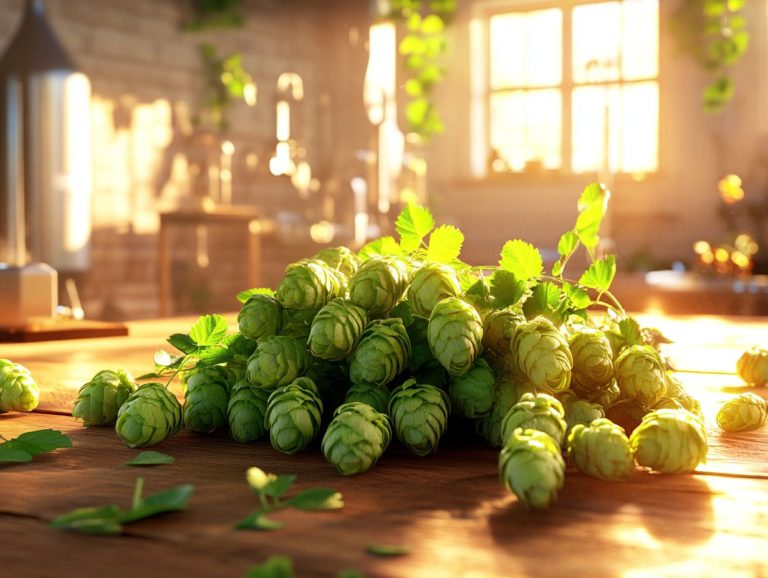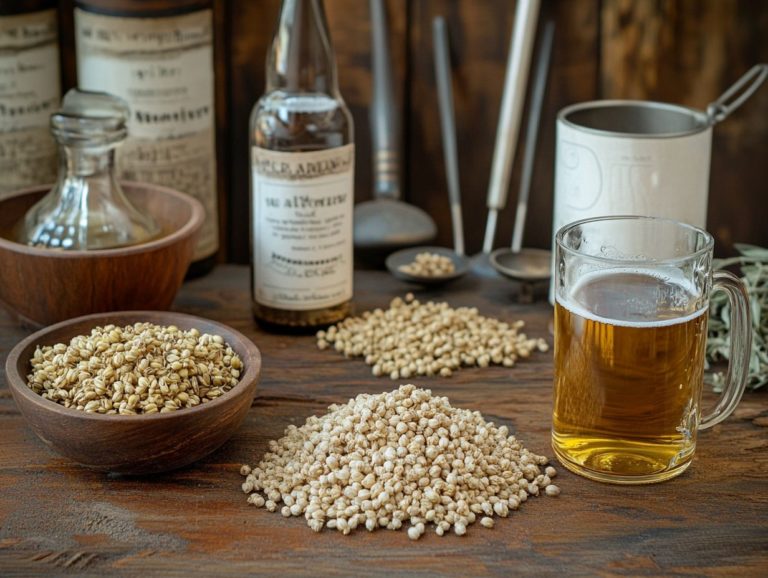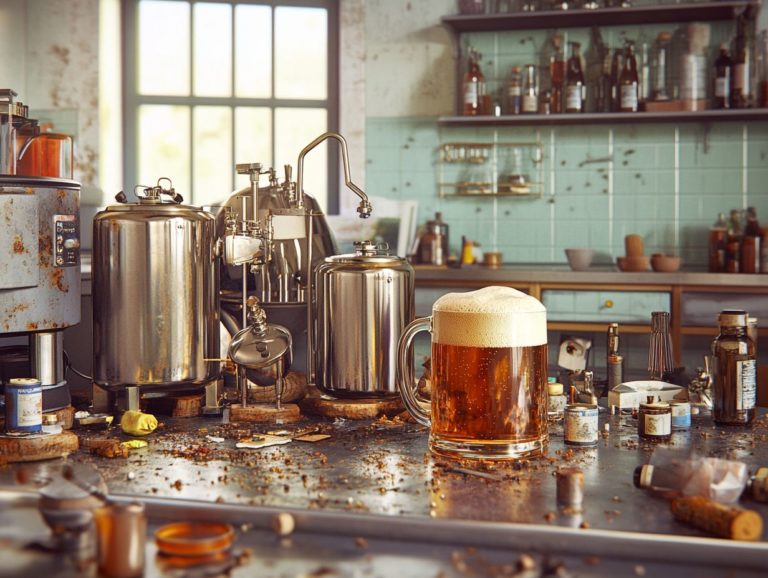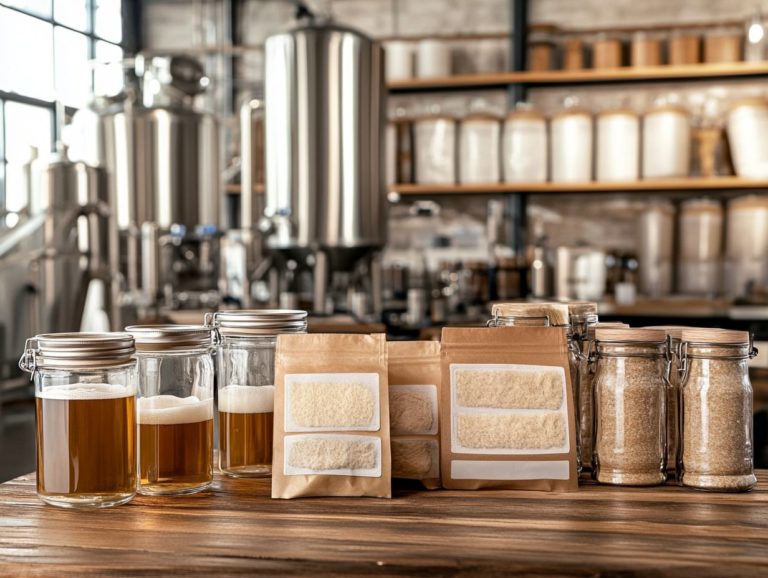How Do I Use a Hydrometer?
Curious about the tool that measures liquid density, original gravity, and specific gravity? A hydrometer may be precisely what you need.
This versatile instrument finds its place in a variety of applications, from brewing and winemaking to aquarium maintenance.
Delve into the intricacies of hydrometers, discovering how they function, the different types available, and their practical uses in the brewing process.
Learn how to use, maintain, and calibrate your hydrometer to ensure accurate readings every time.
Contents
- Key Takeaways for Brewers:
- What is a Hydrometer?
- How Does a Hydrometer Work?
- What are the Different Types of Hydrometers?
- Conclusion
- What Are the Uses of a Hydrometer in Brewing and Beyond?
- How to Use a Hydrometer for Brewing?
- 1. Preparing the Hydrometer and Sample
- 2. Taking the Reading
- 3. Calculating the Results of Your Hydrometer Reading
- How to Maintain, Calibrate, and Use a Hydrometer?
- Frequently Asked Questions about Using a Hydrometer for Brewing
- Hydrometers in Home Brewing
- How can I use a hydrometer to measure the alcohol content of my homemade beer and other brews?
- Is a hydrometer necessary for making homemade wine and other fermented beverages?
- Can a hydrometer be used for liquids other than beer, wine, and cider?
- Are there any other uses for a hydrometer in brewing and beyond?
Key Takeaways for Brewers:
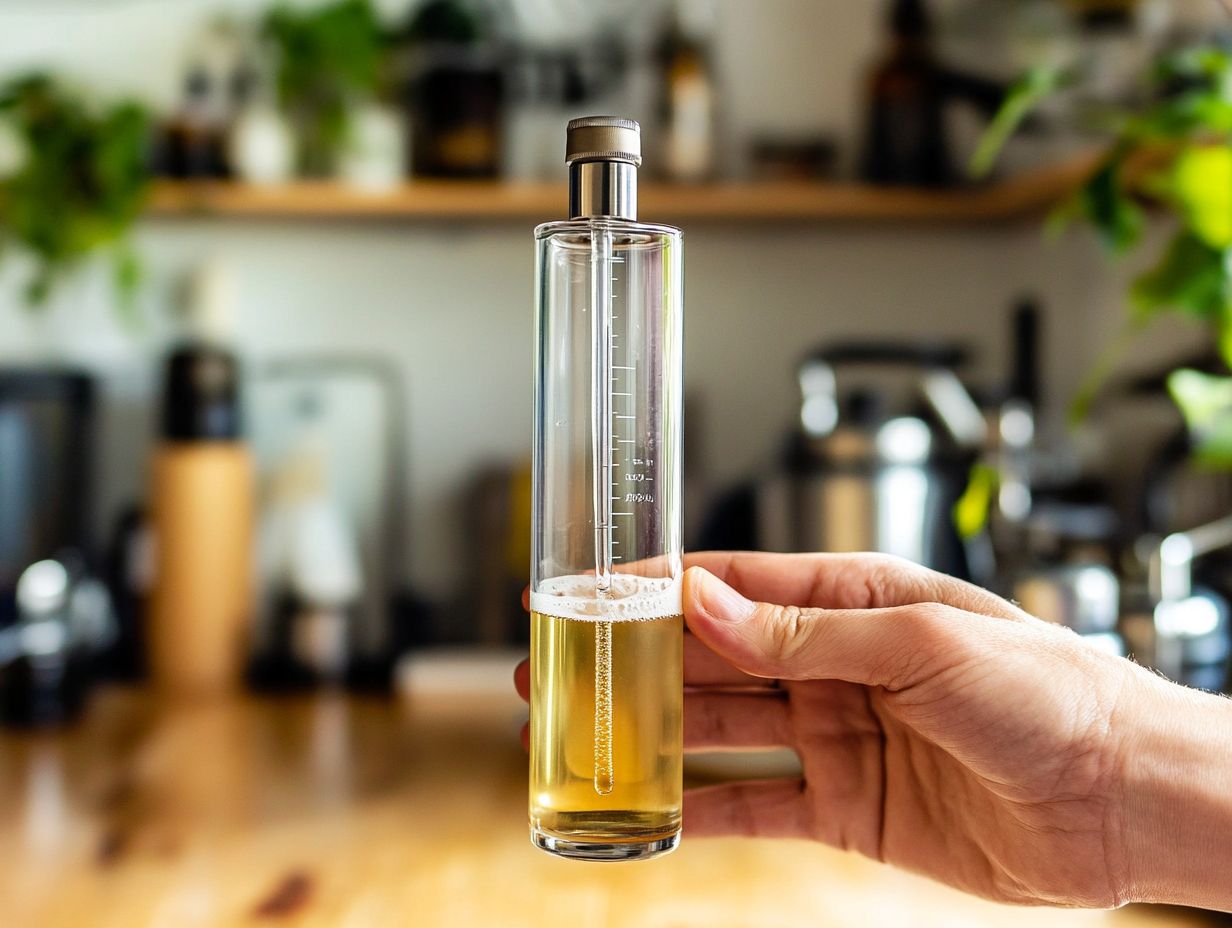
- A hydrometer is a tool used to measure the specific gravity, potential alcohol, and salinity of liquids.
- To use a hydrometer, prepare the instrument and sample, take a reading, and calculate the results.
- Regularly cleaning and calibrating the hydrometer ensures accurate readings and prolongs its lifespan.
What is a Hydrometer?
A hydrometer is a simple instrument used in brewing and various other industries to measure the specific gravity of liquids, which reflects a solution’s density compared to distilled water. By utilizing a hydrometer, you can gauge the sugar content of wort before fermentation, monitor the fermentation process, and ascertain the alcohol percentage in your finished product.
Brewers often rely on these precise measurements to ensure the quality of their recipes. This essential tool is vital for getting accurate measurements, which play a significant role in ensuring the consistency and quality of your beer, wine, and cider production.
How Does a Hydrometer Work?
The hydrometer works on the principle of buoyancy, providing an easy way to measure the specific gravity of a liquid by noting where it floats in the sample. This measurement is crucial for calculating the original and final gravity of your brew.
When you immerse a hydrometer in a liquid like wort, it displaces a volume of liquid equal to its own weight. The depth to which it sinks indicates the liquid’s density.
However, keep in mind that the specific gravity reading can be influenced by temperature fluctuations. To ensure precision in your measurements and gain deeper insights into the fermentation process, it’s essential to apply a temperature correction and consider using a refractometer for more accurate results.
What are the Different Types of Hydrometers?
Hydrometers come in various types, each tailored for specific applications in brewing, beverage production, and science. Among the most common are:
- Brix hydrometer, which measures sugar content in liquids;
- Specific gravity hydrometer, crucial for brewing as it assesses the density of wort;
- Potential alcohol hydrometer, which estimates the potential alcohol percentage in a beverage;
- Salinity hydrometer, designed to determine salt concentration in liquids.
Each type of hydrometer has a distinct purpose, enhancing the precision and accuracy of measurements across various fields.
1. Brix Hydrometer
A Brix hydrometer is a sophisticated tool designed specifically to measure the sugar content in liquids, providing you with the critical data necessary to monitor your fermentation process with precision. Brix readings can be converted to Plato and Balling scales, which are also used in brewing.
By determining the specific gravity of your brew, this instrument enables you to track fermentation accurately, ensuring optimal conditions for yeast activity. The measurement of sugar content is essential, as it directly affects the final alcohol content and flavor profile of your beverage.
Using a Brix hydrometer not only helps you achieve the desired sweetness and balance in your brew but also assists in predicting when fermentation has reached its completion. This functionality is vital for anyone looking to elevate the quality of their products while minimizing the risk of over-fermentation, which could introduce undesirable flavors.
Consequently, integrating a hydrometer into your brewing practices is critical, whether you’re an enthusiastic amateur or a seasoned professional.
Conclusion
Using a hydrometer is essential for crafting high-quality beverages. By understanding how to utilize this tool effectively, you can enhance your brewing process and achieve consistent results. Don’t hesitate to experiment with your own brewing practices!
2. Specific Gravity Hydrometer
The specific gravity hydrometer is an essential instrument in your brewing arsenal, measuring the density of liquids in relation to water. This allows you to monitor the fermentation process with precision.
By assessing the specific gravity of the wort both before and after fermentation, you gain invaluable insights into the fermentation stage. This measurement indicates the concentration of sugars that yeast transforms into alcohol and carbon dioxide, serving as a clear sign of how far along the fermentation has progressed.
Armed with this information, you can also calculate the final alcohol percentage of your brew, enabling you to craft beverages with your desired potency. Ultimately, understanding the changes in density through specific gravity readings ensures that your brewing process consistently delivers high-quality results.
3. Potential Alcohol Hydrometer
A potential alcohol hydrometer, sometimes referred to as an alcohol meter, is an essential tool you ll want in your brewing arsenal. It helps you estimate the potential alcohol content in your brew before fermentation begins, offering you invaluable insights.
This device operates by measuring the specific gravity of the wort the sugary liquid you extract during the mashing process. By taking a specific gravity reading before fermentation kicks off, you can gauge the sugar content, which is vital for determining the potential alcohol percentage.
As fermentation unfolds, the yeast gets to work, consuming those sugars. This process transforms them into alcohol and carbon dioxide. By comparing your initial specific gravity measurement with subsequent readings, you can accurately predict the final alcohol concentration of your beverage.
This measurement technique not only assists you in achieving your desired flavors and alcohol levels, but also helps you maintain consistent quality across your batches.
4. Salinity Hydrometer
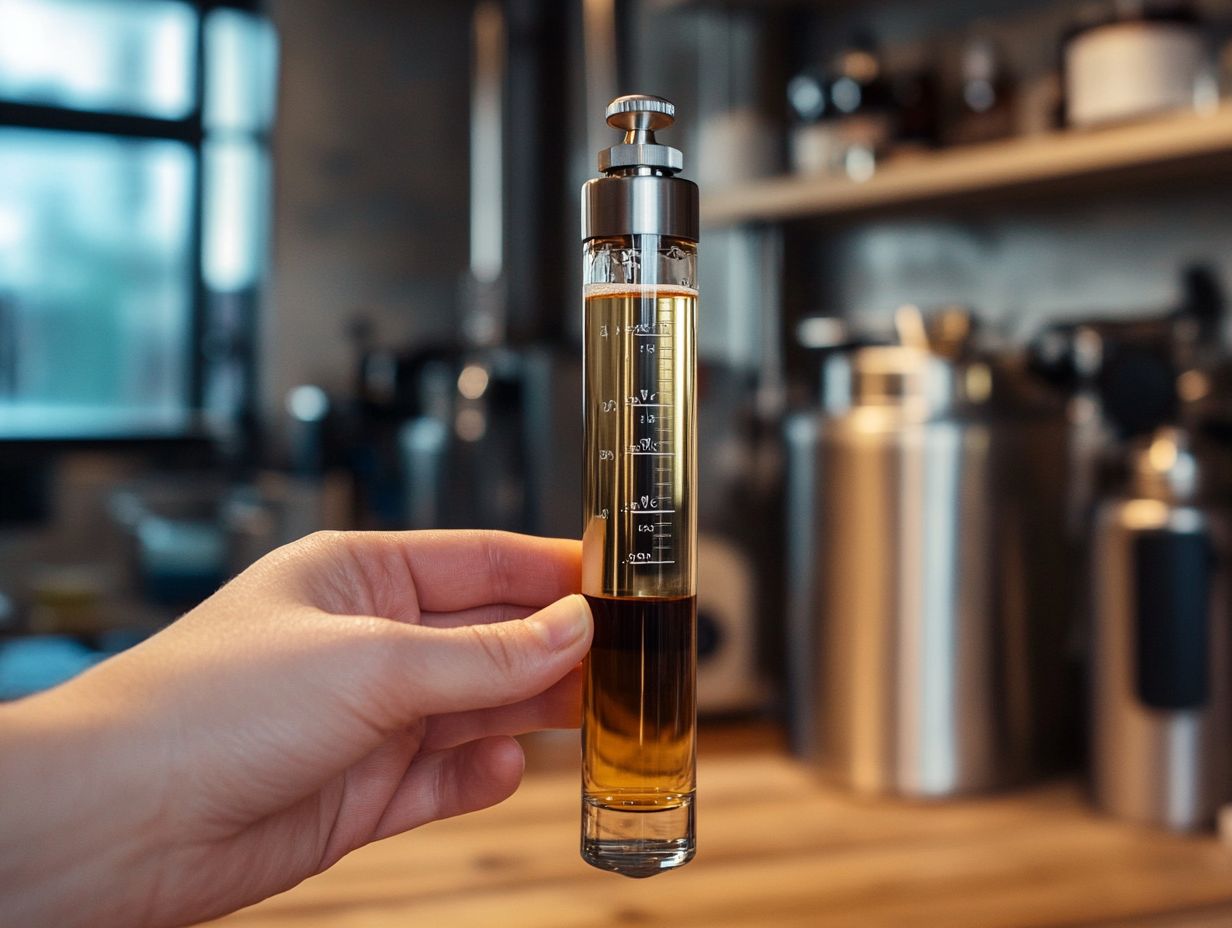
The salinity hydrometer is a specialized instrument crafted to measure the salt concentration in liquids, delivering essential data for a range of applications, including aquaculture and brewing. Its use is crucial for maintaining the right salinity levels in your recipes and brewing process.
This innovative device is important in determining the density and specific gravity of solutions key factors in numerous scientific and industrial processes. By accurately measuring salt levels, you can optimize conditions for marine life in aquaculture, promoting healthy growth rates and ensuring survival.
In the realm of brewing, grasping the nuances of salinity is crucial for achieving the desired flavor profiles and maximizing fermentation efficiency. The salinity hydrometer also proves invaluable for environmental monitoring, enabling researchers to evaluate the effects of salinity fluctuations on ecosystems.
This device is a critical tool across various sectors, significantly enhancing both knowledge and productivity.
What Are the Uses of a Hydrometer in Brewing and Beyond?
Hydrometers are remarkably versatile instruments, finding their place in a range of industries, with brewing being a standout example. They play a crucial role in measuring sugar content, density, and alcohol content, ensuring that the quality and consistency of beverages meet your high standards.
As a brewer, you can utilize hydrometers to monitor the fermentation process by taking sample readings at various stages. This practice allows you to make necessary adjustments and helps you achieve the desired alcohol by volume (ABV).
Hydrometers are equally critical in winemaking and cider production, underscoring their essential role throughout the entire spectrum of alcoholic beverage production. Using a testing tube can help in taking precise hydrometer readings.
Don t miss out on the chance to perfect your brewing process with this vital tool!
1. Discovering Sugar Content in Your Brews
One of the primary uses of a hydrometer is to assess the sugar content of liquids. This is especially crucial in brewing, where it plays a pivotal role in fermentation.
Measure the specific gravity of your liquid to see how much sugar is present before fermentation kicks off. This testing is essential because it allows you to tweak your recipes, achieving your desired level of sweetness or dryness.
Once fermentation is complete, a secondary reading reveals how much sugar has been converted into alcohol. This offers valuable insights into the efficiency of your fermentation. By understanding these metrics, you can make informed decisions about how long to ferment and shape the overall flavor profile of your finished product. This ensures that every sip is a consistent and delightful experience for those who appreciate your craft.
2. Understanding Liquid Density for Better Brewing
Hydrometers are critical tools for measuring the density of liquids. This factor holds significant importance in brewing, wine, cider production, and other scientific applications.
The process is quite straightforward: gently immerse the hydrometer into the liquid and let it float to a level that reveals the specific gravity of the solution. This reading is particularly crucial in brewing because it indicates the sugar content before fermentation begins. For more accurate results, always ensure your hydrometer is well-calibrated before taking a measurement.
By monitoring changes in density over time, you can accurately assess the fermentation process. This ensures that the flavor and quality remain consistent. This measurement technique is equally relevant in fields such as chemistry and environmental science, where a deep understanding of liquid properties is essential for research and development.
3. Accurately Measuring Alcohol Levels
Checking the alcohol content of beverages is an essential use of hydrometers, especially for brewers like you. Accurate data is necessary to evaluate the success of fermentation processes.
By measuring the specific gravity of your liquid at various stages of fermentation, you can determine the potential alcohol content before and after fermentation. This offers you invaluable insights into your brewing journey.
This information allows you to adjust your ingredients and fine-tune fermentation conditions. Maintaining precise alcohol levels is critical for flavor consistency and quality control, as even minor variations can significantly influence both the taste profile and marketability of your beverage. Therefore, hydrometers become critical tools for anyone dedicated to crafting exceptional brews.
4. Keeping Your Aquarium Healthy with Salinity Monitoring
Along with brewing, you can also use hydrometers in aquariums to monitor salinity levels. This ensures your aquatic life thrives in the best conditions for health and growth.
These instruments play a vital role in maintaining the delicate balance of a saltwater or brackish aquarium environment. By accurately measuring the specific gravity of the water, you can determine the salinity, which significantly impacts marine species like fish, corals, and invertebrates.
Regular monitoring with a reliable hydrometer not only helps you prevent salinity stress but also contributes to the overall stability of your ecosystem. Therefore, if you re serious about aquarium care, utilizing hydrometers is essential. Maintaining appropriate salinity levels directly influences the wellbeing and longevity of your aquatic organisms.
How to Use a Hydrometer for Brewing?
Utilizing a hydrometer is a straightforward yet essential process that encompasses several key steps to guarantee precise measurements in brewing, winemaking, and other applications.
- First, prepare both the hydrometer and the sample liquid, usually wort, to ensure that your readings are reliable.
- Next, gently immerse the hydrometer in the liquid. Take care to read the measurement at the surface of the liquid.
This reading will reveal the specific gravity, which is a measure of how heavy your liquid is compared to water. This is critical for evaluating the fermentation stage and calculating potential alcohol content.
Ultimately, accurately interpreting these results enables you to make informed decisions throughout the brewing process.
Grab your hydrometer today and elevate your brewing game!
1. Preparing the Hydrometer and Sample
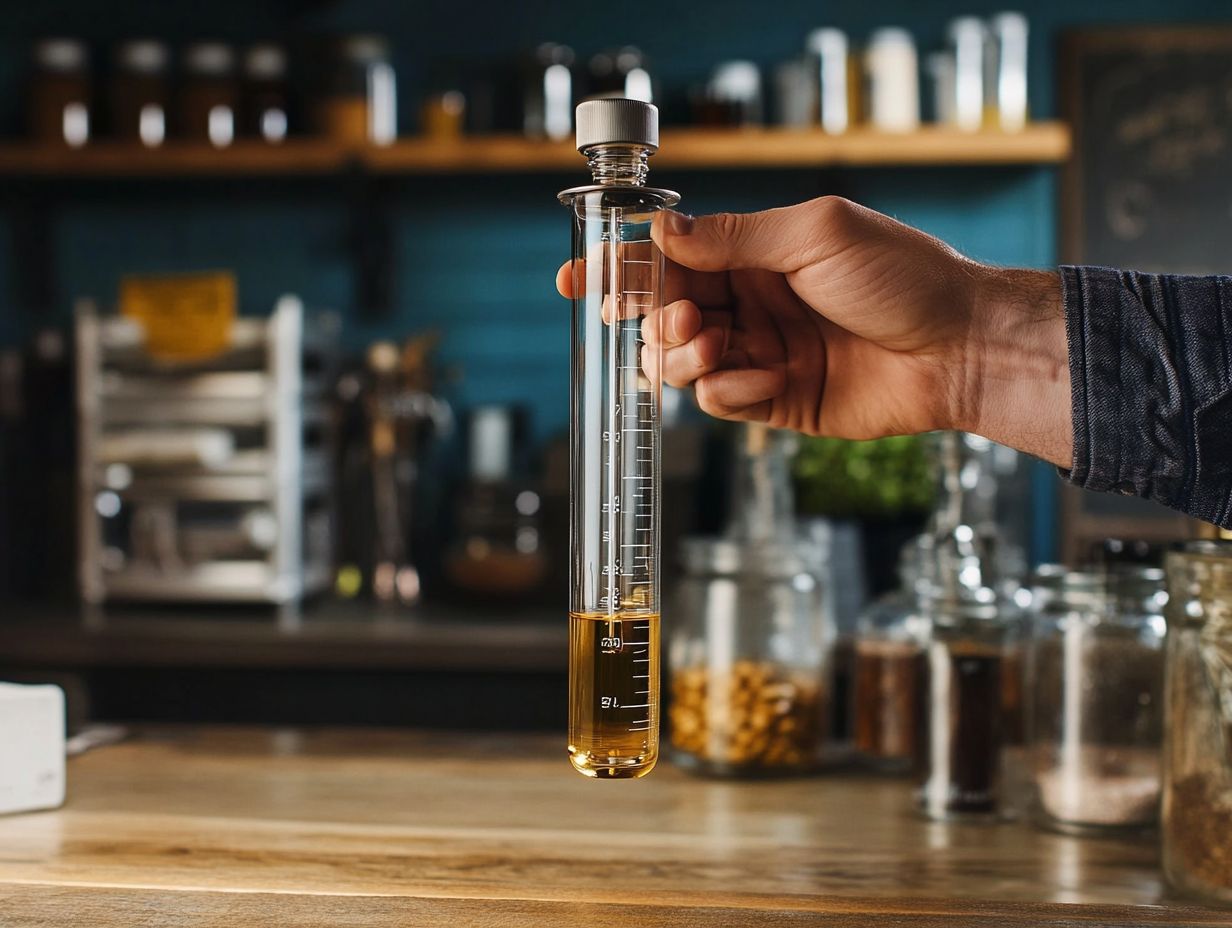
Preparing the hydrometer and the sample is your first crucial step toward achieving accurate measurements. This means ensuring your hydrometer is spotless and that the sample liquid often wort is at the ideal temperature.
To guarantee that your hydrometer delivers reliable readings, it s essential to wash it thoroughly with warm, soapy water and then rinse it with distilled water. This removes any residues that could interfere with its ability to measure density accurately.
Even the slightest contaminant can lead to inaccuracies in your readings. Ensure the wort is cooled to the appropriate temperature, typically around 60 F (15 C), as any temperature variations can significantly affect the hydrometer’s performance.
Investing the time to prepare both the instrument and the sample with care will undoubtedly yield more precise measurements, an essential factor for successful brewing.
2. Taking the Reading
Taking a reading with a hydrometer requires you to carefully submerge the device in the liquid, paying close attention to the point where the liquid surface intersects the scale of the hydrometer.
It s essential to position the hydrometer vertically, ensuring it doesn’t touch the sides of the container to avoid any inaccuracies. You ll want to give it a moment to stabilize before you take your measurement.
Specific gravity significantly affects fermentation processes in brewing or winemaking, which is why precision is paramount.
By making sure no bubbles are clinging to the hydrometer and that you re reading it at eye level, you can achieve a more accurate assessment. This meticulous attention to detail will ultimately lead to better results and a richer understanding of the liquid s density.
3. Calculating the Results of Your Hydrometer Reading
Calculating the results after taking a hydrometer reading is essential for determining the specific gravity and the resulting alcohol percentage in your brewed beverages.
Understanding how to interpret hydrometer readings is crucial, whether you re just starting your brewing journey or you re a seasoned pro.
When you float the hydrometer in a sample of your liquid, the level at which it rests reveals the specific gravity; higher readings indicate a greater sugar content, which is key for estimating the alcohol production during fermentation.
By capturing an initial reading before fermentation gets underway and comparing it to a final gravity reading once it s complete, you can accurately measure the change in specific gravity.
Now, you can easily use this difference in a simple calculation to discover your drink’s strength! This will enable you to effectively assess the strength of your final product.
How to Maintain, Calibrate, and Use a Hydrometer?
Maintaining and calibrating your hydrometer is vital for ensuring its accuracy and longevity, especially in brewing applications where precise measurements are paramount.
Regularly cleaning it after each use will prevent residue buildup that could compromise your readings. Perform periodic calibration checks against a known standard, like distilled water, to ensure your hydrometer delivers reliable data every time.
Storing it properly in a secure environment protects the instrument from damage, allowing it to remain in optimal condition for consistently measuring specific gravity, alcohol content, and other essential parameters in your brewing process.
1. Cleaning the Hydrometer to Ensure Accurate Measurements
Cleaning your hydrometer after every use is essential for maintaining accurate measurements; any residue from previous samples can compromise future readings. This is especially important when switching between different brews like beer, wine, or cider.
To ensure optimal performance, it s vital to adhere to a systematic cleaning routine. Start by rinsing the hydrometer with distilled water to wash away any residues. This initial step is crucial in preventing contamination that could skew your subsequent measurements.
For more stubborn residues, employing a mild detergent and a soft cloth will help you achieve a thorough clean without scratching the delicate glass surface. Using a testing tube can help simplify the cleaning process.
Afterward, it s imperative to rinse once more with distilled water to remove any lingering detergent that could interfere with your readings.
By properly maintaining this instrument, you not only extend its lifespan but also ensure reliable measurements of a measure of how dense a liquid is compared to water across various applications.
2. Calibrating the Hydrometer for Accurate Measurements
Calibrating your hydrometer is essential for ensuring its accuracy, allowing you to trust the readings you obtain during the brewing process, which is crucial for achieving your desired alcohol content. Consider also using a refractometer for comparison.
This intricate calibration process involves comparing your hydrometer’s readings with a known standard, typically distilled water, at specific temperatures. Make sure to calibrate before the brewing season starts to avoid any mishaps! It s advisable to perform this calibration periodically throughout the process, especially after any significant changes in environmental conditions or equipment use.
Regular calibration not only enhances measurement precision but also helps you avoid any erroneous assumptions about fermentation progress and sugar content. Accurate measurements are vital because they ultimately impact the overall quality of your final product and your consistency as a brewer. This reinforces the importance of maintaining this essential practice in your brewing operations.
3. Storing the Hydrometer for Longevity
Protect your hydrometer and keep it thriving for years! Properly storing your hydrometer is crucial for protecting it from damage and ensuring its longevity, which in turn maintains its reliability for all your future measurements. This is particularly important for instruments used in brewing.
To achieve this, make it a point to keep it in a designated storage area that is free from extreme temperatures and direct sunlight; these conditions can easily warp or damage the instrument. Utilizing a protective case or tube will also safeguard it from dust and accidental impacts, further preserving its integrity. Consider a Balling, Plato, or Brix scale hydrometer for specific brewing needs.
Always remember to clean the hydrometer thoroughly after each use, as any residues left behind can lead to inaccuracies in your future readings. By adhering to these best practices, you’ll be able to protect this valuable tool and ensure its functionality remains intact for years to come.
Frequently Asked Questions about Using a Hydrometer for Brewing
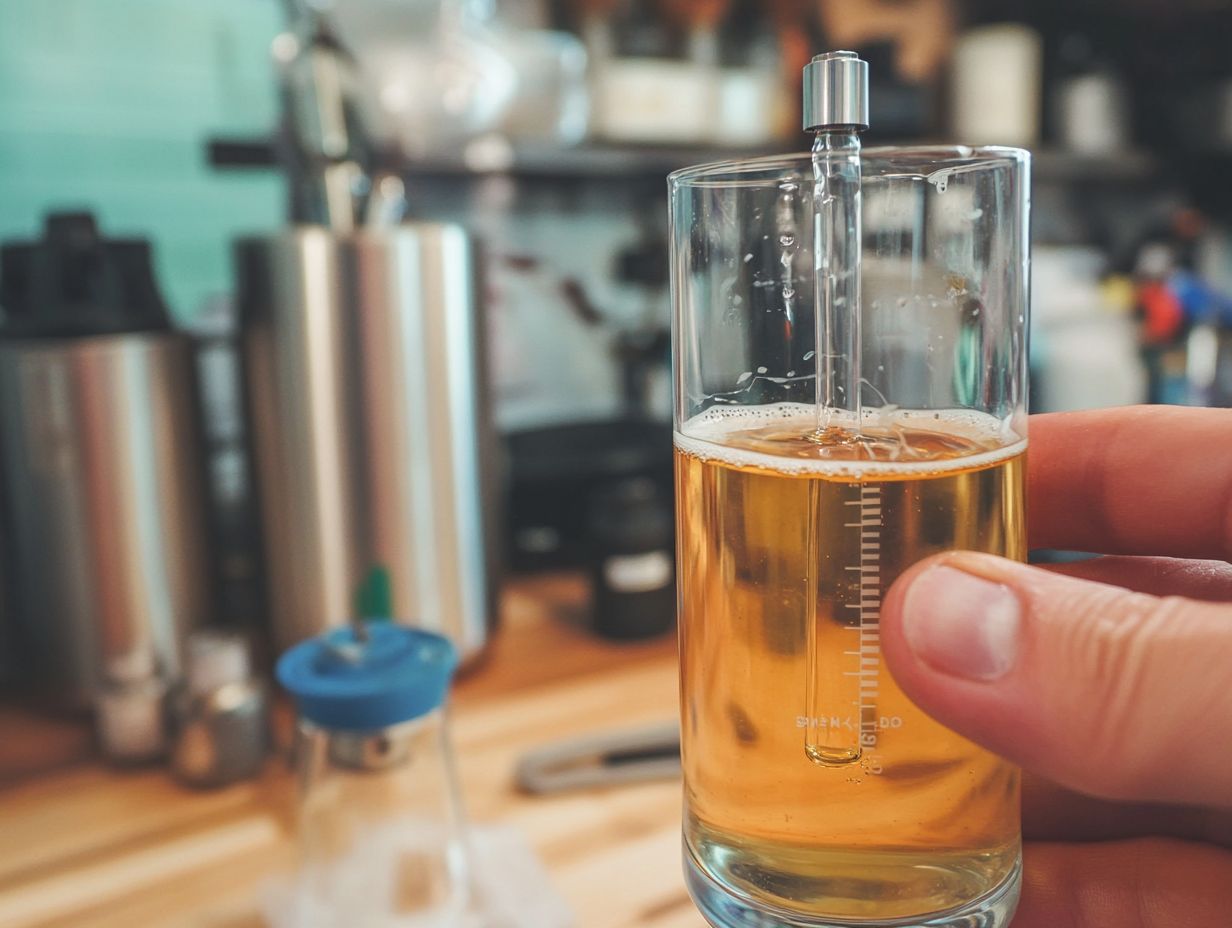
How Do I Use a Hydrometer in Brewing?
A hydrometer is a tool used for measuring the specific gravity of liquids, such as water, beer, cider, or wine. Here are some commonly asked questions about how to use a hydrometer:
What are the Basic Steps for Using a Hydrometer?
To use a hydrometer, you will need a sample of the liquid you want to measure, a test jar or cylinder, and the hydrometer itself. Simply fill the test jar with your wort or liquid, gently lower the hydrometer into the liquid, and take a hydrometer reading where the liquid meets the scale on the hydrometer. Make sure to perform a temperature correction for an accurate measurement of specific gravity.
How do I know if my hydrometer is calibrated correctly and ready for accurate measurement?
Before using a hydrometer, it’s important to make sure it is properly calibrated. To check this, place the hydrometer in distilled water at room temperature and it should read 1.000 on the specific gravity scale. If it doesn’t, you may need to adjust the reading accordingly. Calibration is crucial for accurate measurements in your brewing process.
Hydrometers in Home Brewing
How can I use a hydrometer to measure the alcohol content of my homemade beer and other brews?
To measure the alcohol content of your beer, take two hydrometer readings: one before fermentation (original gravity) and one after (final gravity). The difference between these readings estimates the alcohol content (ABV), revealing how much sugar turned into alcohol during fermentation.
Is a hydrometer necessary for making homemade wine and other fermented beverages?
While a hydrometer isn t strictly necessary for making wine, it s a handy tool that can really enhance your brewing experience. It helps determine the sugar content of the must (unfermented grape juice) and monitors fermentation.
Can a hydrometer be used for liquids other than beer, wine, and cider?
Yes! A hydrometer works for various liquids, including water, milk, and even battery acid. Just ensure you re using one with the right scale for accurate measurements.
Are there any other uses for a hydrometer in brewing and beyond?
A hydrometer measures specific gravity and alcohol content. It’s also great for testing water salinity or the sugar content of fruits and vegetables for jams. Plus, it s invaluable for scientific experiments and industrial quality control.

